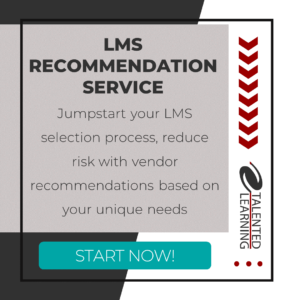
Ever wonder why some software companies constantly seem ahead of the curve in introducing game-changing functionality? Why do their LMS advances tend to capture attention and gain traction? Do innovation leaders know a secret that “me too” laggards lack? What inspires learning tech innovation, anyway?
As an LMS analyst and consultant, these questions are always on my mind. Fortunately, I talk regularly with learning tech founders and CEOs, so answers are never far away. In fact, many of these pioneers have joined me for interviews on The Talented Learning Show Podcast. And here’s what those conversations reveal…
Learning tech innovation doesn’t happen by chance.
How Do Learning Systems Vendors Find Great Ideas?
The best and brightest innovators constantly seek out customers and listen to them. They dig into customer business realities, goals and technology challenges. Then they translate those insights into relevant, scalable learning solutions.
So, spending time with customers is the key to learning tech innovation. That philosophy sounds good in theory. But what does it mean in practice? Is the process formal and structured or organic and ad-hoc? And with unlimited ideas all around, how do these vendors narrow their focus and invest in the most promising possibilities?
You won’t find a one-size-fits-all formula. But I encourage you to read the cross-section of comments below. Even though each company has its own unique approach, I think you’ll find common ground, especially in the customer-related stories these leaders share…
Learning Tech Innovation: Wisdom from Vendor CEOs
Stephan Pineau, CEO, Training Orchestra – View Profile
Episode 48: Managing Hybrid Learning Resources
20 years ago, PeopleSoft and SAP stopped innovating around instructor-led training when the market moved to e-learning. Now there are hundreds of LMSs with e-learning at their core. And today’s training organizations have the very best LMSs. They pay a lot for systems to support online learning. But when they need to find the best available resources for instructor-led training, many still do it manually.
When we ask customers, “How do you control your training investments?” They say, “We use spreadsheets.” But how can you manage $100-$200 million or a year in Excel? How can you manage 500 full-time dedicated instructors and 10,000 subject matter experts that way? It’s not efficient or effective.
Our customers deserve to make the best use of their training budget and time. That’s why we put instructor-led training on autopilot. Now they can streamline planning, communication and collaboration with instructors and learners, and they’re guaranteed to find the best available option.
We want to complement the LMS and the LXP, rather than compete with them. Instead, we focus on the 70% of learning investment involving trainers and training resources. This is what drives learning tech innovation for us.
Do you want more information and analysis on the top 40 learning systems in the world? Buy our 2023 Corporate Learning Systems Market Update report – now available through the 2nd half of this year at a 50% discount!
John Baker, President and CEO, D2L – View Profile
Episode 56: Inside the Modern LMS
The key is to remember people still matter. Technology matters, but it should lead to a better human outcome. And this “people matter” philosophy informs our product strategy. For example, we recently launched a tool we call Creator+, an easy-to-use learning experience authoring engine, based on thousands of interactives we built over the years.
It starts by asking content creators, “What does my organization want from learning?” At D2L, we started with, “What is our learning culture? What tools do we need to support it? What strategies do we need to engage people?”
Starting with your vision for a future state of learning, and tying that to your overall objectives will be a game changer. Because I can tell you, I’ve talked with thousands of CEOs over the last few years. And learning has never been more important for them.
Most learning professionals don’t often have access to the C-suite, much less their CEO. But I can tell you, right now, they’re all struggling with issues involving talent, skills and learning. So the work you do to craft a stronger learning strategy for your company will never be appreciated more by your leadership.
Barry Kelly, CEO and Co-Founder, Thought Industries – View Profile
Episode 55: Advances in Extended Enterprise Learning Systems
Probably 50% or more of our customers are migrating off of homegrown technology that may or may not be integrated with off-the-shelf SaaS products like a CRM or a CMS. In those scenarios, the cost of supporting your technology becomes really high. When your organization is writing code, your product eventually becomes tired. You’re probably spending more time just keeping your technology alive and secure than implementing new features that add business value.
That’s why third-party integrations are key for our business. For our customers, a successful solution is about enabling features rather than building functionality. They can still integrate with remaining homegrown technologies or other ecosystems. But we make it possible to communicate with many adjacent pieces of technology — CRM systems, VILT technologies, certification engines, labs, e-commerce, tax, translation tools. The list goes on.
There’s tremendous benefit from reducing some technical overhead with a partner who’s there to handle delivery headaches every single day. At the same time, by relying on our commitment to ongoing learning tech innovation, you can tap into a roadmap that delivers new features to advance your business. We see this all the time with our customers.
John Peebles, Founder and CEO, Administrate – View Profile
Episode 59: Improving Training Infrastructure
Many of our customers deliver thousands of courses to tens of thousands of learners. They also need to coordinate thousands of instructors, hundreds of classrooms, and hundreds of pieces of equipment. And our platform automates tons of processes to align all those elements.
But despite all of this learning tech innovation, we realized these organizations couldn’t easily build a global training plan. It was an issue for every one of our customers. So we worked on this because we have all the data to answer questions like, “To deliver X class, we need a classroom of Y size, available at A,B,C, times.” And we often bring in data from other learning products, as well.
Actually, this is a classic computer science solver application. It runs thousands of potential solutions to choose the best candidate, and then tries optimizing further within that framework. So AI is definitely involved. The solutions aren’t 100%, but our goal is to help customers get 80% of the way there. Then they can finalize it manually.
Now, it no longer takes these organizations weeks or months to complete next year’s master schedule. Instead, they can set up the process in only 20-30 minutes. Then they tweak those results and run the program again to refine things. So, with much less time and effort they’re achieving much better results.
Do you want more information and analysis on the top 40 learning systems in the world? Buy our 2023 Corporate Learning Systems Market Update report – now available through the 2nd half of this year at a 50% discount!
Brett Strauss, President and Co-Founder, NetExam – View Profile
Episode 58: Inside Channel Training Systems
Mobile training is critical now. I wasn’t a big fan of it 10 years ago. But now a vast majority of training is consumed that way, so learning systems have to accommodate it. And it’s tied to the fact that you don’t have control over channel partner employees. People in sales roles tend to move around quite a bit.
This also means demand is increasing for what we call just-in-time training, where people consume bits of content here and there. And we’re seeing more training embedded into different workflow contexts. For example, we work with automotive software businesses that embed pop-up windows into their systems that link to relevant 5-minute training on-the-fly. And people earn credits for engaging with that content
We’ve also built a way to track informal learning, because all sorts of things happen where knowledge is shared during the work day, right? But too often, none of that is tracked. Now, learning tech innovation makes it possible for people to earn credit for those activities.
Actually, one of our customers was the catalyst for this. Stanley has a healthcare division that builds hospital facilities. And they developed little ID security bracelets for newborn babies. If a baby leaves through an exit, it triggers an alarm. Stanley wanted to train new installers by having them watch seasoned professionals at work. Then veterans would assign credit to new installers.
That’s what got us into informal training tracking. And now you can get credit hours for going to conferences, visiting breakout sessions or visiting a booth where you scan a QR code. What’s great here is that our customers don’t have to create new content. They’re just tapping into a new way to track learning activities and award credit we track within NetExam.
Rich Bartlett, Co-Founder and CEO, CD2 Learning – View Profile
Episode 52: Training Process Automation
Often, customers aren’t sure about the problem they need to solve. So as a true technology partner with a consultative approach, we help unpack their needs. It’s important to understand their core business challenge. For example, are they simply trying to train staff members? Do they need a learning solution that serves internal employees as well as dealer networks? Or do they want to monetize intellectual property?
We interview clients almost as carefully as they interview us, because we want to make sure we’re the right fit. If not, we’ll help them understand why and we’ll help them vet other systems.
Our mission is to help organizations scale training through learning tech innovation. We want to help customers automate onboarding and workflows as successfully as possible. For us, a workflow is more of an onboarding process. But this can apply to all kinds of business scenarios.
Say you want to support activities, tasks or assignments involving more than one person. For example, a sales rep uploads a video “pitch” so a sales manager can review it and comment. This is not just static training. This is a collaborative workflow process with information moving between systems. The manager may request related documents or ask for a meeting to discuss the pitch. Within the same task, they can share feedback, schedule meetings, assign delivery dates and more.
For about two years, we’ve been helping organizations automate workflows with this kind of logic. About 60% of our customers rely on this for employee training, while the other 40% use it to serve their extended enterprise.
Alessio Artuffo, President and COO, Docebo – View Profile
Episode 61: AI in Learning Systems
1) Look beyond obvious use cases
Everyone is focused on low-hanging fruit, like AI-generated content recommendations. But it’s important to think bigger. For example, imagine automatically tailoring learning experiences to an individual’s level of introversion or proficiency in a particular skill set. Or consider how AI can improve workforce DEI by reducing unconscious bias in recruiting and performance management decisions.
2) Security and privacy matter
Companies want to know what happens with AI decision data. Customers want to know, “Are you using my data? Are you sharing it with others? Are you doing statistical analysis? Should I be worried?”
So we’re building a control panel that lets organizations make granular decisions about how to treat AI-generated data. You can build your own “vault” of internal AI data sets, where the algorithm operates only with your organization’s behaviors, rather than blending your data with other companies. And you can opt in or out.
3) AI doesn’t mean we can ignore the human factor
AI is powerful and will be pervasive. But it’s not a substitute for people. Our customers still want top performers to share their knowledge and expertise. They want their best people to do more qualitative work, not quantitative work that can be automated. And chat is not a substitute for that.
So think of AI as an opportunity for professional improvement, rather than fearing that it will take over your job. Everyone will be affected by this kind of learning tech innovation. But we need to be flexible about the logic behind our jobs, so we can adjust as technology helps redefine our work focus and priorities.
Conclusion
Whew. I hope you found some useful takeaways in that whirlwind tour of learning tech innovation! I’ll share more collective wisdom from learning systems CEOs again soon. But today, after reviewing these podcast excerpts, I can say with confidence that if I were betting on the future of learning systems, I would put my money on companies that obsess over their customers’ needs, interests and feedback. What about you?
Thanks for reading!
Need Help Finding an Innovative LMS?
Fill out the form below to schedule an introductory consulting session with our Lead Analyst, John Leh:
Share This Post
Related Posts
The Future of Customer Education: Customer Ed Nugget 16
Customer education is rapidly evolving as organizations embrace new strategies and tech. What does this mean for the future of customer education? See what experts say on this Customer Ed Nuggets episode
Education Strategy Mistakes to Avoid: Customer Ed Nugget 15
What does it take to deliver a successful customer education program? It starts with a solid education strategy. Learn how to avoid common pitfalls on this Customer Ed Nuggets episode
Which LMS is Best for You? New Shortlisting Tool for 2024
How can you find the best learning system for your business? Our LMS shortlisting tool can help. Learn about the 2024 RightFit Solution Grid. Free, reliable guidance based on our independent research
How to Build a Learning-Based Business: Executive Q&A Notes
Building and selling online courses may seem easy, but building a profitable learning-based business is far more complex. Find out what successful leaders say about running this kind of business
The Rewards of Community Building: Customer Ed Nugget 14
What role does community play in your customer relationships? Find out why community building is such a powerful force in customer education on this Customer Ed Nuggets episode
Benefits of Training Content Syndication: Customer Ed Nugget 13
If you educate customers online, why should you consider content syndication? Discover 10 compelling business benefits in this Customer Ed Nuggets episode
Top Marketing Skills to Master: Customer Ed Nugget 12
Successful customer education programs depend on professionals with expertise in multiple disciplines. Which marketing skills lead to the best results?
How to Measure and Improve Partner Training ROI
An educated channel is a successful channel. But how do you know if your educational programs are effective? Learn from an expert how to evaluate partner training ROI
Mistakes in Ongoing Customer Training: Customer Ed Nugget 11
Customer education doesn't stop with onboarding. It pays to invest in ongoing customer training. Learn which mistakes to avoid in this Customer Ed Nuggets episode














FOLLOW US ON SOCIAL